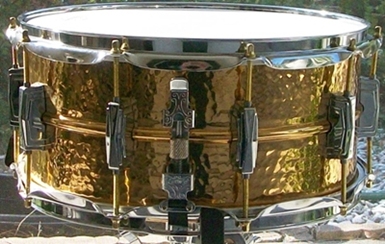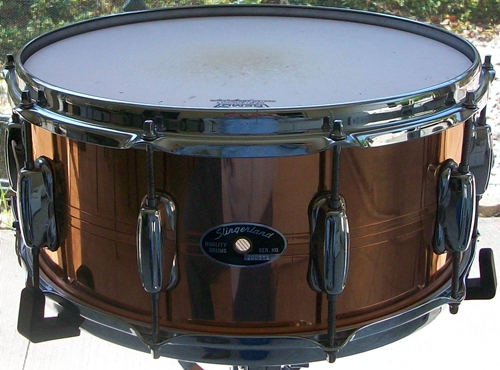Friday, April 2, 2010
Properties of Drum Shells and Bearing Edges
Thursday, April 1, 2010
Wood or Metal Shells? Here's a Compromise
I have a personal theory that preferences are often based on the first snare drum a drummer owns. I prefer wood snare drums, and it's probably because my first drum kit in 1964 came with a wood snare drum. The sonic characteristics of our first snare drums tend to imprint us. Wood snare drums are typically warmer than metal, and have tonal qualities that a metal snare drum cannot deliver. Metal, and especially brass, tends to project more, sound brighter, and - when tuned a certain way - has a "honk" that appeals to many drummers.
Certain snare drums, however, have sonic characteristics of both shell types. The Slingerland copper snare drum I discussed in my last post has wood-like sound qualities. Part of the reason is the copper shell, which gives the drum a softer, almost diffused tone.
There is another class of metal shell that possesses the same qualities: hammered metal. I own two, both made from different types of metal, that would fool many in a blindfold test.
The first is my Ludwig 6.5x14 hammered bronze snare drum:

That is the snare drum that induced me to try metal sell snare drums. The hammering dried out the sound sufficiently to give it a distinct wood tone, and the bronze shell contributed to the tone and sensitivity, making it ideal for brushwork. In fact, it is an extraordinarily sensitive drum considering the shell depth. At first I wasn't sure if it was the bronze shell or the hammering that imparted the sonic qualities I found so desirable. I became convinced after I acquired another hammered shell snare drum - a 5x14 hammered Supraphonic:

Not only is the depth more shallow, but the shell is made from Ludalloy (Ludwig's term for chrome plated aluminum.)
Like the bronze shell model, the hammered Ludalloy model is drier than a standard Ludalloy Supraphonic, and has wood-line tone.
To truly ensure that it's the hammering and not the shell material I tested out a Ludwig 5x14 hammered brass Black Beauty. The test was apples-to-apples against the Ludalloy hammered Supraphonic in that the depths were identical. Result: same dry, woody quality as the other hammered shell snare drums. It was actually a surprise because brass is a much brighter sounding metal when used for drum shells.
The conclusion is if you want a snare drum that shares some of the most important characteristics of both wood and metal, then a hammered shell snare drum (or one with a copper shell) may be the best solution. I've used Ludwig snare drums as examples because I own and have first hand experience with them. Most major drum companies offer hammered shell snare drums, mainly made from brass, including Gretsch, Pacific, Peace and Worldmax. They are worth a look if you are seeking a versatile snare drum that has tone with a bit more projection.
Wednesday, March 31, 2010
Slingerland 6.5x14 Copper Snare Drum


The Zoomatic strainer has always been the weak link on any Slingerland snare drum from any era in my opinion. However, the one on this particular snare drum works well. I did disassemble it to clean and lubricate it, which accounts for the problem-free operation it gives me.
The drum itself sounds wood-like. This quality comes from the relatively thin, copper shell. It also has a fairly wide tuning range - a surprise - and is one of the better snare drums I have for brushwork.
Because it has a deep shell and because of the thin, copper construction, it is well suited for low volume venues. Controlling the dynamic range, particularly in the PPP to F range, poses no problem with 7A sticks.
I've gotten the best results with the resonant head tuned high and the batter medium. If you tension the snare wires low this snare drum makes buzz rolls and shuffles sound amazing. The wires will go to medium tension before they choke, so it is probably not the best choice for heavy backbeat music.
I have had this snare drum for a few years, but rediscovered it today when I was looking for another snare drum. It is now set up on my kit as the snare drum in rotation for this week. Sometimes owning 60 snare drums can be a curse as well as a blessing because you can often overlook a gem. I can assure you it will get a workout this week.
Monday, March 29, 2010
Inexpensive Video Recording Solutions
If you teach there is a lot of value in recording your students' lessons for playback and critique.
Finally, having an inexpensive video recorder is great for sharing tips and techniques - or even gigs - with fellow drummers. YouTube is full of such videos, and many are great learning experiences (not the mention the self confidence you gain from posting your drumming.)
The current darling of the music world is the Zoom Q3 Video Recorder. The key strength of this particular recorder is the outstanding audio capture, which has no rival in low-end video recording devices. Moreover, it does not need an external microphone. What it lacks is truly good video capture. In order to obtain decent video you need very good lighting. Also, despite the Zoom name, it's zoom features are abysmal at best. For recording practice sessions and lessons it is, in my opinion, weak. For capturing performances, however, it is my first choice because of the audio features.
Here is the manufacturer's product review that steps through the main features:
Another review, done by the great Peter Erskine, is not as slick, but he used the Q3 to make the video, so you will get a more realistic view.
If, like me, your main use is as a practice or lesson aid, then you may find the Kodak Zi8 Pocket Video Camera to be better suited to your needs. One key advantage is, unlike the Q3, you can purchase an inexpensive remote control for the Zi8 . This is an essential feature for any recording device that is used to capture practice sessions (unless you can convince someone to operate the recorder for you.) A quick summary of features is provided in this manufacturer's video:
As mentioned, the remote control feature alone sets this recorder apart from the Q3 for capturing practice sessions. The video is better than the Q3, although the audio is not going to come close to what you can achieve with the Q3.
While both the Q3 and the Zi8 function well as hand held recorders, for recording practice sessions you are going to need a tripod. My favorite is the Vista Explorer 60" tripod because it is easy to adjust to any angle, sturdy and relatively inexpensive.
There are other video recording solutions besides the two I mentioned. I feel that the Q3 and the Zi8 are two of the best values for low-end solutions, and each has key strengths for different purposes: the Q3 for recording live gigs or making demos, and the Zi8, with the add-on remote control, for recording practice sessions and lessons.